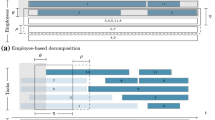Abstract
This paper addresses a multi-activity multi-day shift scheduling problem in a continuous and flexible environment including a heterogeneous workforce. Given days-off schedules associated with each employee, our objective is to construct and assign admissible multi-activity shifts to employees on their work days in a way that minimizes under-staffing and over-staffing with a restricted budget on workforce cost. A hybrid heuristic which combines tabu search with a branch-and-bound procedure is proposed to solve the problem. The computational experiments prove that our method provides good schedules in relatively short computing times.



Similar content being viewed by others
References
Aykin, T. (2000). A comparative evaluation of modeling approaches to the labor shift scheduling problem. European Journal of Operational Research, 125, 381–397.
Baker, K. R. (1976). Workforce allocation in cyclical scheduling problems: A survey. Operational Research Quarterly, 26, 155–167.
Barnhart, C., Hane, C., & Vance, P. (2000). Using branch-and-price-and-cut to solve origin-destination integer multicommodity flow problems. Operations Research, 48(2), 318–326.
Bechtold, S. E., & Jacobs, L. W. (1990). Implicit modeling of flexible break assignments in optimal shift scheduling. Management Science, 36(11), 1339–1351.
Côté, M., Gendron, B., Quimper, C., & Rousseau, L. (2011a). Formal languages for integer programming modeling of shift scheduling problems. Constraints, 16(1), 54–76.
Côté, M., Gendron, B., Rousseau, L., (2007). Modeling the regular constraint with integer programming. Integration of AI and OR Techniques in Constraint Programming for Combinatorial Optimization Problems, pp. 29–43.
Côté, M., Gendron, B., Rousseau, L. (2010). Centre interuniversitaire de recherche sur les réseaux d’entreprise, l. l. e. l. t., 2010. Grammar-Based Column Generation for Personalized Multi-Activity Shift Scheduling. CIRRELT.
Côté, M.-C., Gendron, B., & Rousseau, L.-M. (2011b). Grammar-based integer programming models for multiactivity shift scheduling. Management Science, 57(1), 151–163.
Dantzig, G. B. (1954). Traffic delays at toll booths. Journal of the Operations Research Society of America, 2(3), 339–341.
Demassey, S., Pesant, G., Rousseau, L. (2005). Constraint programming based column generation for employee timetabling. Integration of AI and OR Techniques in Constraint Programming for Combinatorial Optimization Problems, pp. 830–833.
Demassey, S., Pesant, G., & Rousseau, L. (2006). A cost-regular based hybrid column generation approach. Constraints, 11(4), 315–333.
Ernst, A. T., Jiang, H., Krishnamoorthy, M., & Sier, D. (2004). Staff scheduling and rostering: A review of applications, methods and models. European Journal of Operational Research, 153, 3–27.
Glover, F., & McMillan, C. (1986). The general employee scheduling problem: An integration of MS and AI. Computers & Operations Research, 13(5), 563–573.
Jin, J. (2009). Pré-affectation des Taches aux Employés Effectuant des Taches Non-interruptibles et des Activités Interruptibles. Master’s Thesis, école Polytechnique, Montréal, CANADA.
Lequy, Q., Bouchard, M., Desaulniers, G., Soumis, F., Tachefine, B., (2012). Assigning multiple activities to work shifts. Journal of Scheduling, 15(2), 239–251.
Quimper, C., & Rousseau, L. (2010). A large neighbourhood search approach to the multi-activity shift scheduling problem. Journal of Heuristics, 16(3), 373–392.
Rekik, M., Cordeau, J.-F., & Soumis, F. (2004). Using benders decomposition to implicitly model tour scheduling. Annals of Operations Research, 128, 111–133.
Rekik, M., Cordeau, J.-F., & Soumis, F. (2010). Implicit shift scheduling with multiple breaks and work stretch duration restrictions. Journal of scheduling, 13(1), 49–75.
Salvagnin, D., & Walsh, T. (2012). A hybrid mip/cp approach for multi-activity shift scheduling. Principles and practice of constraint programming (pp. 633–646). Heidelberg: Springer.
Talbi, E. C. (2009). Metaheuristics from design to implementation. Hoboken: Wiley.
Acknowledgments
This work was supported by the Fonds de recherche du Québec Nature et Technologie (FRQNT) through its new researchers start-up grant. This support is gratefully acknowledged. We are grateful to two anonymous referees for their valuable comments.
Author information
Authors and Affiliations
Corresponding author
Rights and permissions
About this article
Cite this article
Dahmen, S., Rekik, M. Solving multi-activity multi-day shift scheduling problems with a hybrid heuristic. J Sched 18, 207–223 (2015). https://doi.org/10.1007/s10951-014-0383-z
Received:
Accepted:
Published:
Issue Date:
DOI: https://doi.org/10.1007/s10951-014-0383-z




